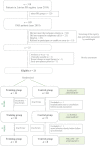Individually tailored home-based physiotherapy program makes sustainable improvement in exercise capacity and daily physical activity in patients with pulmonary arterial hypertension
- PMID: 36314474
- PMCID: PMC9629575
- DOI: 10.1177/17534666221132477
Individually tailored home-based physiotherapy program makes sustainable improvement in exercise capacity and daily physical activity in patients with pulmonary arterial hypertension
Abstract
Background: Pulmonary arterial hypertension (PAH) is a rare, chronic, progressive, and life-threatening cardiopulmonary disease. This study investigated the impact of an individually tailored 12 weeks home-based physiotherapy program in PAH patients, with the aim to evaluate change in exercise capacity and daily physical activity level.
Methods: This was an analysis of secondary outcomes from a prospective, randomized, controlled intervention study. Twenty-one participants were recruited from the Latvian PH registry based on inclusion criteria and randomized in a training group (TG) and control group (CG). Both groups continued a medical target therapy, but for TG, the individually tailored home-based physiotherapy program was added including physical exercises, relaxation, self-control, education, and supervision with telehealth elements. Outcomes included a 6-min walk test (6MWT) (m) and daily physical activity based on accelerometry results assessed at baseline, after 12 weeks, and at follow-up 6 months after commencement of intervention.
Results: 6MWT distance significantly (p < 0.05) and clinically (>33 m) increased within TG after 12 weeks (51.8 m, 95% CI = 25.7-77.9 m, Cohen's d = 1.7) and at follow-up (75.5 m, 95% CI = 46.1-104.8 m, Cohen's d = 2.1). A significant difference in 6MWT results between the groups at 12 weeks and follow-up was approved. In TG, low-intensity activities significantly (p < 0.05) increased both after 12 weeks (Cohen's d = 1.6) and at follow-up (Cohen's d = 1.2), moderate-intensity activities significantly (p < 0.05) increased at follow-up (Cohen's d = 1.3), and no significant improvements were present in CG.
Conclusion: The individually tailored 12 weeks home-based physiotherapy program comprising comprehensive physical exercise training, relaxation, self-control skills training, and education, added to stable medical target therapy and supervised by physiotherapist through telehealth elements, is effective in improving exercise capacity and increasing daily time in low or moderate physical activities 6 months after commencement of the intervention in patients with PAH.
Keywords: daily physical activity; exercise; home-based; individually tailored; physiotherapy; pulmonary arterial hypertension; rehabilitation; self-control skills.
Conflict of interest statement
The authors declare that there is no conflict of interest.
Figures





References
Publication types
MeSH terms
LinkOut - more resources
Full Text Sources
Miscellaneous

